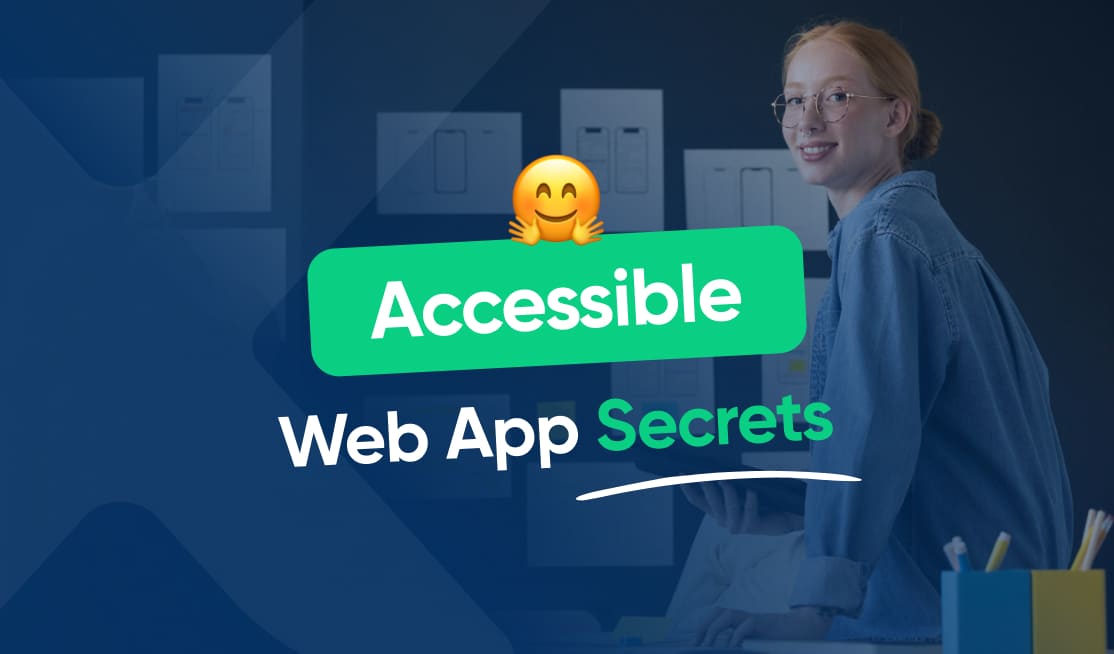
Web accessibility is a crucial aspect of modern web development. Ensuring that your web applications are accessible to all users, regardless of their abilities, is not only a legal requirement in many countries but also a moral and ethical responsibility.
Understanding Web Accessibility
Before we delve into the nitty-gritty of creating accessible web applications, let’s first understand what web accessibility is all about. Web accessibility refers to the inclusive practice of making websites and web applications usable and accessible to all people, including those with disabilities or impairments.
When we talk about web accessibility, we are not just talking about compliance with legal requirements or guidelines. It goes beyond that. Web accessibility is about creating an inclusive digital environment that empowers individuals with disabilities to access and engage with online content, services, and opportunities.
Importance of Web Accessibility
Web accessibility is an essential aspect of building a user-centric web. By making your web applications accessible, you are ensuring that all users, regardless of their abilities, can access and interact with your content effectively. This not only improves user experience but also opens up your applications to a wider audience, potentially increasing your reach and impact.
Imagine a person with visual impairments trying to navigate a website that lacks proper alternative text for images or has poor color contrast. Without these accessibility features, the user may struggle to understand the content or even be unable to access it at all. By prioritizing web accessibility, you are removing barriers and providing equal opportunities for everyone to participate in the digital world.
Key Principles of Web Accessibility
When it comes to web accessibility, there are several key principles to keep in mind. These principles, often referred to as POUR (Perceivable, Operable, Understandable, and Robust), provide a solid foundation for creating accessible web applications that meet the needs of all users.
Perceivable: Make sure that all information and user interface components are presented in a way that can be perceived by all users. Provide alternatives to non-text content, such as images, and ensure that all content is easily distinguishable by using appropriate color contrast.
Operable: Ensure that users can interact with all user interface components and navigate your web applications using alternative input methods, such as keyboard navigation. Provide clear and consistent navigation options to help users find their way around your applications.
Understandable: Make your web applications easy to understand by using clear and concise language, providing instructions, and offering error prevention and correction mechanisms. Consider the diverse needs and abilities of your users when designing your applications.
Robust: Create web applications that can be interpreted reliably by a wide range of user agents, including assistive technologies. Use valid and semantic HTML, follow web standards, and provide fallback options for non-supported features.
By adhering to these principles, you are not only ensuring compliance with accessibility guidelines but also creating a more inclusive and user-friendly web experience for all individuals, regardless of their abilities or impairments.
Designing for Accessibility
Design plays a crucial role in creating accessible web applications. By considering accessibility from the early stages of the design process, you can ensure that your applications are not only visually appealing but also usable to all users, regardless of their abilities.
When it comes to designing for accessibility, it’s essential to go beyond the basics and delve into the nuances that can truly enhance the user experience. One aspect to consider is the use of alternative text for images, which is crucial for users who rely on screen readers to navigate the web. Providing descriptive and meaningful alt text can make a significant difference in how users with visual impairments engage with your content.
Color and Contrast
Color contrast is an important consideration when it comes to web accessibility. Ensure that there is sufficient contrast between text and background colors to make your content readable for users with visual impairments. Use color combinations that are WCAG 2.0 compliant to provide a pleasant and accessible viewing experience.
Moreover, consider incorporating additional design elements such as texture and patterns to complement color contrast and enhance the overall visual appeal of your web applications. These elements not only contribute to a more engaging user experience but also provide alternative cues for users with color vision deficiencies.
Typography and Readability
Choose fonts and typography styles that are easily readable for all users, including those with visual impairments. Opt for fonts with clear glyphs and appropriate letter spacing. Use font sizes that can be resized without impacting the readability of your content.
Navigational Considerations
Navigation is a critical aspect of web accessibility. Design intuitive and well-organized navigation systems that allow users to navigate through your applications effortlessly. Consider providing skip navigation links, breadcrumb trails, and ARIA landmarks to improve the overall accessibility of your applications.
Furthermore, implementing keyboard navigation support and ensuring focus indicators are clearly visible can greatly benefit users who rely on keyboard navigation or assistive technologies to interact with your web applications. These considerations can significantly enhance the accessibility and usability of your designs across a diverse range of users.
Developing with Accessibility in Mind
Development is where the rubber meets the road when it comes to creating accessible web applications. By following best practices and utilizing accessible technologies, you can ensure that your applications are built with accessibility in mind from the ground up.
Semantic HTML for Accessibility
Using semantic HTML tags is a fundamental practice in building accessible web applications. By structuring your content using proper heading tags (<h1>, <h2>, etc.) and utilizing landmark roles (<header>, <nav>, etc.), you provide a logical and understandable structure to assistive technologies and screen reader users.
For example, imagine you’re creating a blog post. Instead of using a generic <div> to wrap the title, you can use an <h1> tag to indicate that it’s the main heading of the page. This not only helps with search engine optimization but also provides clear navigation for screen reader users.
In addition, using landmark roles such as <header> and <nav> can further enhance the accessibility of your web application. These roles help assistive technologies understand the purpose and structure of different sections of your page, making it easier for users to navigate and comprehend the content.
Accessible JavaScript
JavaScript is a powerful tool in web development, but it can also introduce accessibility barriers if not used correctly. Ensure that your JavaScript interactions are accessible by providing keyboard accessibility, handling focus properly, and using ARIA attributes to communicate dynamic changes to assistive technologies.
For instance, if you have a dropdown menu that expands when a button is clicked, make sure that users can navigate through the options using the keyboard alone. This allows individuals who rely on keyboard navigation, such as those with motor disabilities, to access the menu without any barriers.
Additionally, managing focus is crucial for accessibility. When a user interacts with a JavaScript component, such as a modal dialog, ensure that the focus is properly moved to the relevant element and that it can be easily identified by assistive technologies. This way, screen reader users can understand the context and purpose of the component.
ARIA Roles and Properties
The Accessible Rich Internet Applications (ARIA) specification provides a set of roles, states, and properties that allow developers to enhance the accessibility of their web applications. By using ARIA roles and properties effectively, you can provide additional context and make your applications more understandable and usable for assistive technology users.
For example, if you have a form with required fields, you can use the ARIA attribute aria-required="true" to indicate to screen reader users that those fields must be filled out. This helps individuals with visual impairments understand the form requirements and ensures they don’t miss any important information.
Furthermore, ARIA roles such as role="alert" and role="status" can be used to provide important notifications or updates to assistive technology users. This ensures that individuals who rely on screen readers are aware of any dynamic changes happening on the page, such as error messages or successful form submissions.
Testing for Accessibility
Testing is an integral part of creating accessible web applications. It ensures that your applications meet the necessary accessibility standards and provides an opportunity to identify and fix any accessibility issues before your applications go live.
Automated Accessibility Testing Tools
Automated accessibility testing tools can help you quickly identify common accessibility issues in your web applications. These tools analyze your code and provide recommendations to address any accessibility gaps. However, keep in mind that automated testing is not exhaustive and should be complemented with manual testing.
Manual Accessibility Testing
Manual accessibility testing involves testing your web applications using assistive technologies, such as screen readers or keyboard-only navigation. By simulating the experience of users with disabilities, you can identify usability and accessibility issues that may not be detected by automated testing tools.
Maintaining Accessibility in Web Applications
Creating accessible web applications is an ongoing process. It requires regular maintenance and updates to ensure that your applications remain accessible as technologies evolve and new accessibility standards emerge.
Regular Audits and Updates
Perform regular accessibility audits to identify any new accessibility issues that may arise in your web applications. Keep up-to-date with the latest accessibility standards and best practices and make necessary updates to your applications to maintain their accessibility.
Training and Awareness for Teams
Creating a culture of accessibility within your development team is crucial for maintaining the accessibility of your web applications. Provide training and resources to educate team members about accessibility best practices and encourage them to prioritize accessibility in their development workflow.
By following these guidelines and implementing accessibility best practices, you can ensure that your web applications are inclusive and accessible to all users. Remember, accessibility is not a one-time task but an ongoing commitment to creating a web that truly caters to the diverse needs of its users.


